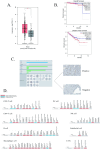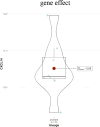CXCL14 in prostate cancer: complex interactions in the tumor microenvironment and future prospects
- PMID: 39755616
- PMCID: PMC11700453
- DOI: 10.1186/s12967-024-06022-9
CXCL14 in prostate cancer: complex interactions in the tumor microenvironment and future prospects
Abstract
CXCL14 is a highly conserved chemokine expressed in various cell types, playing crucial roles in both physiological and pathological processes, including immune regulation and tumorigenesis. Recently, the role of CXCL14 in tumors has attracted considerable attention. However, previous pan-cancer studies have reported inconsistencies regarding the effects of CXCL14 on tumors, particularly concerning its expression levels in tumor tissues and its influence on various phenotypes of cancer cells. This variability is believed to stem from the context-dependent nature of CXCL14, as different sources of CXCL14 and its secretion within distinct tumor microenvironments may mediate diverse biological effects. Such phenomena have also been observed in prostate cancer research. Despite a foundational understanding of CXCL14 in prostate cancer, there remains a lack of comprehensive reviews summarizing the specific roles of this chemokine and systematically analyzing the reasons behind its complex effects. Therefore, this article aims to discuss the role of CXCL14 in the tumor microenvironment of prostate cancer and explore future research directions and potential applications.
Keywords: CXCL14; Chemokines; Prostate cancer; Tumor microenvironment.
© 2025. The Author(s).
Conflict of interest statement
Declarations. Ethics approval and consent to participate: Not applicable. Consent for publication: Not applicable. Competing interests: The authors declare no conflict of interests.
Figures




Similar articles
-
The roles of Y-box-binding protein (YB)-1 and C-X-C motif chemokine ligand 14 (CXCL14) in the progression of prostate cancer via extracellular-signal-regulated kinase (ERK) signaling.Bioengineered. 2021 Dec;12(2):9128-9139. doi: 10.1080/21655979.2021.1993537. Bioengineered. 2021. PMID: 34696665 Free PMC article.
-
CXCL14 is an autocrine growth factor for fibroblasts and acts as a multi-modal stimulator of prostate tumor growth.Proc Natl Acad Sci U S A. 2009 Mar 3;106(9):3414-9. doi: 10.1073/pnas.0813144106. Epub 2009 Feb 13. Proc Natl Acad Sci U S A. 2009. PMID: 19218429 Free PMC article.
-
Epigenetic mechanisms of promigratory chemokine CXCL14 regulation in human prostate cancer cells.Cancer Res. 2010 Jun 1;70(11):4394-401. doi: 10.1158/0008-5472.CAN-10-0427. Epub 2010 May 11. Cancer Res. 2010. PMID: 20460540 Free PMC article.
-
Chemokine CXCL14; a double-edged sword in cancer development.Int Immunopharmacol. 2021 Aug;97:107681. doi: 10.1016/j.intimp.2021.107681. Epub 2021 Apr 28. Int Immunopharmacol. 2021. PMID: 33932697 Review.
-
The multifarious roles of the chemokine CXCL14 in cancer progression and immune responses.Mol Carcinog. 2020 Jul;59(7):794-806. doi: 10.1002/mc.23188. Epub 2020 Mar 24. Mol Carcinog. 2020. PMID: 32212206 Free PMC article. Review.
Cited by
-
Revisiting the role of cancer-associated fibroblasts in tumor microenvironment.Front Immunol. 2025 Apr 17;16:1582532. doi: 10.3389/fimmu.2025.1582532. eCollection 2025. Front Immunol. 2025. PMID: 40313969 Free PMC article. Review.
References
-
- Gowhari Shabgah A, et al. Chemokine CXCL14; a double-edged sword in cancer development. Int Immunopharmacol. 2021;97: 107681. - PubMed
-
- Dai C, et al. CXCL14 displays antimicrobial activity against respiratory tract bacteria and contributes to clearance of Streptococcus pneumoniae pulmonary infection. J Immunol. 2015;194(12):5980–9. - PubMed
-
- Hara T, Tanegashima K. Pleiotropic functions of the CXC-type chemokine CXCL14 in mammals. J Biochem. 2012;151(5):469–76. - PubMed
Publication types
MeSH terms
Substances
Grants and funding
LinkOut - more resources
Full Text Sources
Medical

